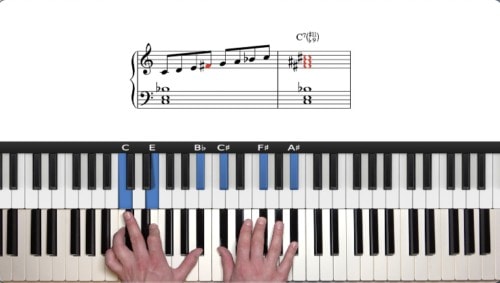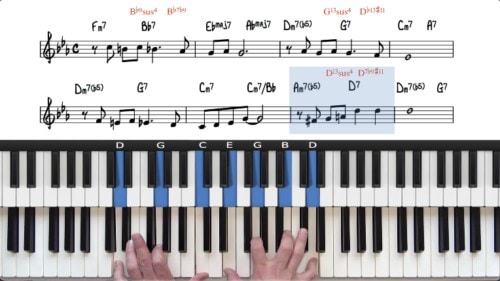“Pure Imagination” For Beginners
In this lesson we create a beginner-focused arrangement of the tune “Pure Imagination” from Willy Wonka & The Chocolate Factory.
We first arrange the tune using simple root-3-7 voicings and we pay attention to the major and minor 251s so that we know how to identify and navigate this common progressions. We then go through the form again and enhance our voicings with chord extensions and chord alterations.
Suspended Harmony
An interesting aspect of this tune is that it features a lot of suspended harmony; also known as sus chords. We will analyse the role of the suspended voicings and discuss how they fit into the harmonic framework of the tune.
We have created an advanced arrangement of this tune and whilst this is a beginner-focused lesson, we will hint at some of the more advanced arranging techniques. If you’d like to learn more you can check out the full advanced tutorial here.
Related Theory Lessons
The following theory areas have been covered in detail in other lessons, click the links below if you would like to learn more about these topics:
Practice Tips
-
"Pure Imagination" follows an AABA form which means that the first 8 bars repeat 3 times with slight variations.
-
Once we have memorised the melody and the harmony of the first 8 bars, we in fact have memorised almost 75% of the tune.
-
First learn to play through the tune with simple R-3-7 voicings, and then gradually layer in some chord extensions and alterations.
-
Experiment with the suspended voicings in the 251s. We can resolve the suspended 4th, or alternatively hold the suspension.
-
Listen to the different textures created by adding 9ths and 13ths to sus voicings.
-
The advanced arrangement demo features a lot of passing chords and reharmonisations. If these theory areas are new to you, check out the related lessons list above.







Hayden—-it took me a few weeks of learning to get to a new level of understanding—-and Pure Imaginations is what I used my ‘breakthrough’ on. Upon starting this tune, I spent solid practice time really knowing the melody and writing the chord progressions over and over again. Once I felt confident in this step, I played the block chords with my left hand——and then in combination with the melody. At that point, I allowed myself to learn the voicing arrangement on your tutorial.
In general, I can play this song much better than the first few attempts (The Nearness of You, Days of W and R) and will most likely continue with the next jazz standard using this sequence of learning steps.
I still have sudden brain glitches—-which is sometimes hard because of the hours spent learning. I do try to remember your advice to be patient and that this is a learning process which will take years.
In conclusion——I very much enjoyed having this be my first jazz standard in my repertoire especially as I loved watching Charlie and the Chocolate Factory as a kid;)
Toby
Hi Toby,
Happy New Year!
That’s great news.
With each new tune that we learn, the next ones become easier and easier. It’s very much a numbers game and once we get to around 20 or so tunes you will be comfortable picking up a lead sheet and creating something that sounds at least pleasing to the ear.
Your sequence of learning steps sounds great and if it works for you, definitely stick with it.
Cheers,
Hayden
Just want to point out that the first chord Hayden is playing in measure 21 is actually an Am7(b5) not an Abm7(b5) as the lead sheet shows (both in the video and the downloads).
Thanks for this comment. I just got confused by this as well and came here to figure it out or offer the correction. Glad to know I wasn’t mixed up!
Love this lesson. Been working on it for a while and finally got it.
Hi Rory,
I will fix that typo in the lesson and on the downloads – my mistake there.
Sometimes these little typos creep into the lessons and so if ever in doubt, follow the actual demonstrations/performances in the video.
Congrats on learning the arrangement and check out this tutorial for the advanced version: pianogroove.com/jazz-piano-lessons/pure-imagination-tutorial/
Enjoy the lessons and happy new year!
Cheers,
Hayden
I noticed that too, Lee. Seems to work pretty well both ways. I look forward to the day when I know how many ways to change chords to have them makes sense to the year and be more colorful. Hayden wrote previously that Most students I have a jump in understanding after they have about 20 standards under their belt. 19 more to go.
Is there a transcription for this one? I have really appreciated that on the other beginner arrangements. It’s helpful to be able to go back and compare what you did to the lead sheet without having to watch the lesson again.
Hi Branson,
Yes I can create a full transcription no problem. Apologies this was missed when adding the lesson and downloads.
I will get to work on it immediately.
Cheers and enjoy the lessons!
Hayden
Thank you so much! I really enjoy these lessons. It’s a phenomenal program.
My pleasure Branson and glad to hear you are enjoying the lessons.
I aim to get the transcription finished tomorrow.
Cheers,
Hayden
Hi Branson,
I have added 2 new PDF files. The first one contains the beginner chords and voicings where we stick to mostly roots, 3rds, and 7ths, with the melody on top.
The other PDF contains the advanced voicings, reharmonisations, and passing chords.
Let me know if I can help further.
Stay safe!
Cheers,
Hayden
Hey thank you! I really appreciate. And I really appreciate how quickly you responded. This is a really great program.
I have enjoyed PianoGroove for a year, and was just notified my next year has been paid. but I cannot access anything. tried this, which I spent loads of time learning, so if I can’t access this I am in trouble.
thanks for technical help, Richard Gross
I first saw the free video of your lesson on Pure Imagination on Youtube. I loved the lovely voicings and the clear discussion. I joined yesterday and downloaded the advanced version music of this tune. Sure it’s beyond me right now but I wanted to study it to be sure I understood your arranging ideas.
I think there is a typo at measure 33 first chord. I think the F in the bass clef should be Gb.
Also I was wondering about measure 5 4th beat. You have the Ab and Bb in the bass clef also shown in the treble clef. I assume we don’t need to play these same notes with both hand but is this a composing convention to show meaning of the voicing more clearly? Or would it be clearer to drop the duplication in the right hand?
I really psyched this starts as a beginning lesson and moves into intermediate. A lot of online piano seems to be for beginners which is fine but I’m glad to find this graduated approach. Thank you!!
Hi John,
Thanks for the comment.
Yes you are correct measure 33 should be a Gb and not an F. Also yes there are some inaccuracies in bar 5 where beat 4 should be C-Eb-F-Ab in the right hand which is a block chord style voicing with the Ab doubled underneath in the left hand.
My notation skills are not as sharp as my arranging skills! :–) If you are ever in doubt please follow the demonstration in the actual video lessons and I appreciate you letting me know. I will correct both of these and re-upload the file.
Yes you might also like to check out the course on “Georgia” where we start with the most basic arranging techniques and gradually add more complex voicings, you can find that course here: pianogroove.com/jazz-piano-lessons/bluesy-stride-piano-beginners/
This month I have been recording a new course called “cocktail improvisation for beginners” which focuses on the tune “Misty” and follows a similar format to the “Georgia” course above but with more of an improvisational focus. It’s coming along really nicely and I’m aiming to have it done in the next week or so. More updates to follow!
You might also like to check out the “Moon River” lessons in this course: pianogroove.com/jazz-piano-lessons/functional-harmony-course/ – again we start simple and then add lots of interesting substitutions and reharmonisations.
Take a look over the lesson links above and let me know if I can help further.
Cheers,
Hayden
Great tutorial. One typo, the minor 2-5-1 says Ab instead Amb5-D7-Gm.
The printouts are fine. It’s just on the video. Ignore my comment.
Hi Marina,
Thanks for letting me know about the typo in the video – I will fix this and refresh the video.
If I can help further just let me know.
Talk soon,
Hayden
Hayden, I know it’s been years since you created this lesson but for a number of those years, rheumatoid arthritis prevented me from doing piano playing so I spent my time watching your lessons, listening and learning music theory. But some changes in medications (or maybe just visualizing playing the chords in your arrangement), I slowly learned this song from your videos. Last week I blew away my old in-person piano teacher (now dear friend) who listened to me on Facetime play “Pure Imagination.” He was astounded (as was I). So, just know that whether your students are all constantly commenting in these comment boxes or not, you and the exquisite PG team of musician/teachers (shout out to Tuomo) have made many of our musical dreams come true. Thank you.
Hi Lonnie,
Thanks so much for your lovely message. I will pass that onto Tuomo.
I’m really glad to hear on your piano progress in spite of the arthritis. Congratulations.
Yes this is a lovely tune to play – it’s also one of favourites.
Please let me know if I can help with anything you are working on and talk soon.
Best,
Hayden
I am brand, brand new to this website. Thought I’ve played and taught piano for many years (not jazz though), I am committed to consciously going backwards before moving forwards. That being said, I was knocked out on the reharm voicing on Pure Imagination!! Gorgeous and thrilling inspiration. Now , back to my 251’s😄👍
Dane Andrus, Sacramento, Calif.
Hi The video breaks up when it gets to the bridge and returns to the A section. I can’t follow through to the end of the song.
Can this glitch be fixed? Thanks!